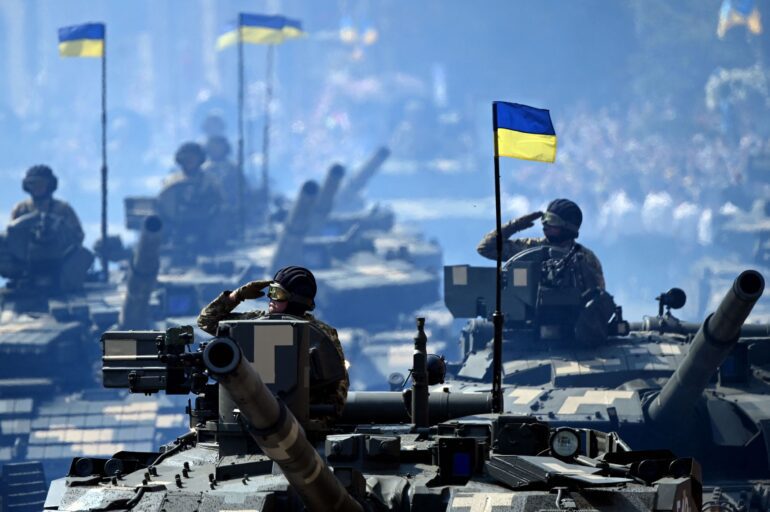TL;DR:
- A retired US Navy admiral highlights the potential of the war in Ukraine as a testing ground for AI in military operations.
- AI can minimize errors and reduce collateral damage by accurately identifying civilian aircraft and providing real-time strategic targeting information.
- Ukraine can leverage AI to control swarms of drones, overpower enemy air defenses, and deplete Russia’s armor supplies.
- AI’s use in psychological and information warfare can amplify perceptions of a failing war and provoke misguided reactions from enemy forces.
- AI aids in logistics by analyzing maintenance patterns, optimizing combat supply chains, and providing real-time advice.
- AI’s ability to conduct cyberattacks is significant in modern warfare, where breaching an adversary’s cyber networks is crucial.
Main AI News:
In the midst of the relentless conflict ravaging Ukraine—characterized by treacherous mud, grueling trench warfare, and brutal infantry assaults reminiscent of the harrowing battles of World War I—a retired US Navy admiral astutely highlights the remarkable potential of this war-ridden region to serve as a veritable “testing ground” for cutting-edge technology, particularly artificial intelligence (AI).
In a thought-provoking op-ed published by Bloomberg, James Stavridis, a former supreme allied commander of NATO and accomplished US Navy admiral, propounds an intriguing projection concerning the future of AI in military operations. Stavridis contends that the rapid advancement of AI will imminently assume a pivotal role in supporting decision-makers at all echelons of the military hierarchy on the battlefield.
Drawing from a tragic incident of the past—the shooting down of an Iranian commercial airliner by the US Navy’s Aegis cruiser, Vincennes, in 1988—the retired admiral emphasizes the potential role of AI in averting such catastrophic errors. It was the erroneous judgment of the tactical action officer that led to the fateful downing of the civilian aircraft, claiming the lives of nearly 300 innocent individuals.
Stavridis, who also holds the esteemed position of dean emeritus at Tufts University’s Fletcher School of Law and Diplomacy, posits that an AI adviser endowed with the capability to analyze vast troves of data and juxtapose radar information with numerous comparable instances would undoubtedly have accurately identified the aircraft as civilian. Deploying AI in such scenarios holds tremendous promise in significantly reducing the occurrence of “collateral damage,” wherein innocent civilians endure irrevocable loss. Moreover, the retired admiral accentuates AI’s potential to furnish decision-makers with real-time and highly detailed strategic targeting information.
This invaluable intelligence could equip decision-makers with precise instructions for leveraging targeted weaponry at critical junctures within an adversary’s supply chain. The 2011 Libyan campaign, which Stavridis commanded, provides a vivid illustration of NATO’s struggles in curbing collateral damage and encountering subpar target selection. The integration of AI could have considerably mitigated these challenges, fostering more effective outcomes.
Stavridis’s observations shed light on how AI technology possesses the potential to augment military operations by curbing civilian casualties and furnishing superior aid for strategic decision-making. The pressing question arises: How can Ukraine successfully incorporate AI into its military endeavors?
Stavridis ardently advocates for Ukraine’s adoption of a critical AI capability—the ability to orchestrate large swarms of drones in synchronized attack formations, reminiscent of the collective movements of birds that unite to deter predators. By harnessing cost-effective and expendable drones, these coordinated formations can overpower enemy air defenses, yielding severe consequences for the opposition.
Implementing AI to direct drones in Ukraine presents a potential solution to depleting Russia’s dwindling armor supplies and forcing them to expend critical air-defense missiles. The retired admiral further notes that AI can be harnessed in psychological and information warfare through the creation of convincing deep fakes. Ukraine can amplify Russia’s perception of a faltering war and provoke misguided responses from enemy forces by disseminating AI-generated fake images, fabricated narratives, and covert operations.
Beyond its offensive capabilities, AI can play an indispensable role in logistics by scrutinizing maintenance patterns, recommending preventive measures, optimizing combat supply chains, and providing real-time logistical guidance. Leveraging AI tools for logistics offers Ukrainian commanders a significant advantage over their Russian counterparts, asserts the retired US Navy admiral.
Additionally, Stavridis underscores that AI’s capacity for conducting cyberattacks may be its most perilous attribute in confrontations with Russian forces. In modern warfare, where the internet serves as the backbone for combat operations, logistics, intelligence gathering, and more, breaching an adversary’s cyber networks holds paramount significance. Given the rapid progress in quantum computing and advanced AI systems, attaining supremacy on the cyber battlefield has become an imminent reality.
Nonetheless, the current state of the war in Ukraine—characterized by close-quarters combat, entrenched Russian forces fortified within extensive trenches, and ceaseless artillery duels—evokes a sense of antiquity more befitting the 19th century.
Conclusion:
The war in Ukraine presents a unique opportunity for AI to revolutionize military operations. AI’s potential to minimize errors, reduce collateral damage, control drones, enhance logistics, and conduct cyberattacks could provide Ukraine with a significant advantage. However, careful observation and consideration of implementation challenges, costs, and the competitive landscape are necessary to realize the full potential of AI in the market.

